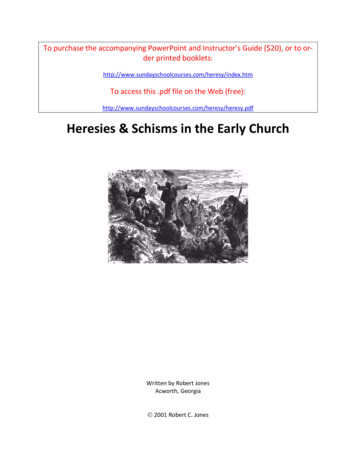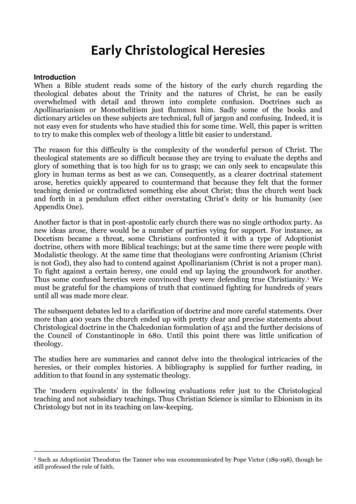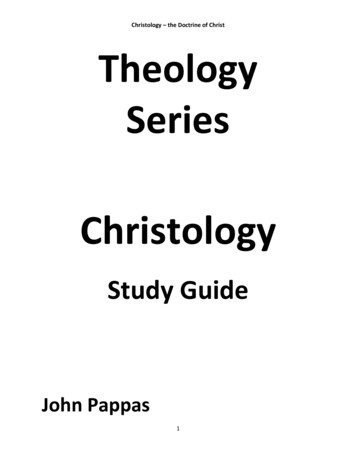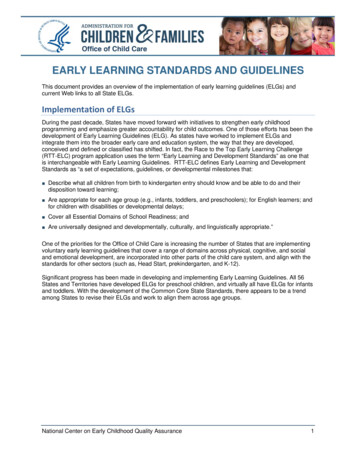
Transcription
To purchase the accompanying PowerPoint and Instructor’s Guide ( 20), or to order printed /index.htmTo access this .pdf file on the Web eresy.pdfHeresies & Schisms in the Early ChurchWritten by Robert JonesAcworth, Georgia 2001 Robert C. Jones
Christian Theology and History Adult Sunday School CoursesRobert Joneswww.sundayschoolcourses.comI’ve always been a strong believer in adult Sunday School classes and Bible studies in our churches. And manychurches have quality, Biblically-based adult-focused programs. Unfortunately, just as many churches tend todownplay adult education, focusing on children’s education (not a bad thing in itself), or focusing on the needs ofthe “unchurched”, where topics such as church history and theology are often purposely ignored.Yet there is a strong need for adult education focused on both the Bible and the basic tenets and history of theFaith. Among the reasons: Not all adults come from a strong childhood background in the church – adult Sunday School classes/Biblestudies may be their first serious introduction to what Christianity is all aboutChristianity (and especially Evangelical Christianity) is under constant attack from the media and popularculture (movies, music, etc.). We need to give fellow Christians the tools to defend the Faith against attack (or to provide a “ready defense” as Peter says in 1 Peter 3:15)Even adult Christians that have a strong Biblical background often know little about the origins and historyof their FaithTo better meet the needs of adult Christians (both those mature in their Faith, and those just starting out in the“School of Christ”), I’ve written a series of courses that focus on the history of the Christian Church (including theJewish roots), as well as the development of doctrine in the Church. The topics represented in these courses areintended to both further the participant’s walk in the Faith, as well as serve as a starting point for Christian apologetics.While the primary purpose of these courses is for use in churches, they also may be useful for High School and College projects, especially the courses focused primarily on historical aspects.One note: these courses are primarily written from an Evangelical Protestant viewpoint (I come from a ReformedChurch background), but I hope I've given ample time to other points of view throughout the various courses.Cover: Albigensian worshippers on the banks of the Rhone (Engraving from Wylie)2
Heresies & Schisms in the Early ChurchWritten by Robert JonesAcworth, GeorgiaCopyright 2001 Robert C. JonesTo purchase the accompanying PowerPoint and Instructor’s Guide ( 20), or to order printed /index.htmTo access this .pdf file on the Web eresy.pdf"Scripture taken from the HOLY BIBLE, NEWINTERNATIONAL VERSION. Copyright 1973,1978, 1984 by International Bible Society. Used bypermission of Zondervan Publishing courses.com3
Table of ContentsHERESIES & SCHISMS IN THE EARLY CHURCH . 1CHRISTIAN THEOLOGY AND HISTORY ADULT SUNDAY SCHOOL COURSES. 2TABLE OF CONTENTS. 4INTRODUCTION . 5DEFINITIONS.5HERESY QUIZ.6GNOSTICISM . 6ORIGINS AND INFLUENCES.7NEW TESTAMENT REFUTATIONS AND REFERENCES .9GNOSTIC SOURCES .10HERESIES AND SCHISMS IN THE FIRST FIVE CENTURIES . 12SIMON MAGUS.12VALENTINIAN GNOSTICISM.12MARCION .13RESPONSE OF THE CHURCH TO 2ND CENTURY GNOSTICISM .14MONTANIST HERESY .15ORIGEN: ON THE BORDERLINE .15MANICHAEISM .16DONATISTS .17ARIANISM .18PELAGIANISM .19NESTORIANISM .20CONCLUSION . 21SOURCES . 21ABOUT THE AUTHOR . 234
Introduction“For as they are heretics, they cannot be true Christians, because it is not from Christ that they get thatwhich they pursue of their own mere choice, and from the pursuit incur and admit the name of heretics.Thus, not being Christians, they have acquired no right to the Christian Scriptures; and it may be very fairly said to them, “Who are you? When and whence did you come? As you are none of mine, what have youto do with that which is mine? Indeed, Marcion, by what right do you hew my wood? By whose permission, Valentinus, are you diverting the streams of my fountain?” (Tertullian, The Prescription against Heretics”)In this course we will attempt to look at some of the primary heresies and schisms of the first five centuries of the Christian Church, starting with New Testament references, and continuing through to the battles of St. Augustine against the Pelagians. Along the way, we’ll examine the Gnostics (against whommuch of the Apostles Creed was written), the followers of Arius (against whom much of the NiceneCreed was written), the Donatists, and others.Why bother to study heresies and schisms that, purportedly died out 1500-1800 years ago? Becausestrains of, say, Gnosticism have reappeared in modern religious systems such as the “New Age” movement, which sometimes claims to be compatible with Christianity. A good example of the modernechoing the ancient might be seen by comparing the following quote from Star Trek V (spoken in a dialogue between Captain Kirk and Dr. McCoy after the enterprise has failed to find “God” in the “center”of the Universe), and a quote from 3rd century heretic Monoimus:Star Trek V: Dr. McCoy: “Is God really out there?”Captain Kirk: “Maybe he’s not out there, Bones. Maybe he’s here – *in the human heart”Monoimus: “ seek for Him from (out of) thyself, and learn My God (is) my mind, my understanding, mysoul, my body if you accurately investigate these (points), you will discover (God) Himself, unity and plurality, in thyself, according to that title, and that He finds the outlet (for Deity) to be from thyself.” (TheRefutation of All Heresies, Chapter 8, Hippolytus, Translated By The Rev. J. H. Macmahon, M.A)Most heresies in the first five centuries centered around differing opinions on exactly whoChrist was, what manner of being he was, and what the relationship was between Christand God the Father.DefinitionsBefore we embark on this journey, we should consider a few definitions. The term heresy (as it is usedtoday) means:"An opinion or doctrine not in line with the accepted teaching of the church; the opposite of orthodoxy"(Holman Bible Dictionary)The term comes from the Greek hairesis, which can mean “the act of choosing”, but was also occasionally used in the Bible to mean sect or party. The term is used in various ways in the New Testament, asthe chart below indicates:ReferenceActs 5:17, 15:5, 26:5UsageParty or sect5
ReferenceActs 24:14, 28:221 Cor 11:19, Gal 5:20,Titus 3:102 Pet 2:1UsageUsed by Jews to describe groups thathad left the mainstream of JudaismUsed by Paul to describe those thatcaused dissensionUsed by Peter to describe FalseProphetsThe Gnostics were a prominent example of early “Christians” whose views on doctrine were radicallydifferent than those of the established church.Another term that will prove useful in this discussion is schism, or an "ecclesiastical cleavage". Schismatics didn’t necessarily disagree with Church doctrine, but rather disagreed with Church Law or practice. Novatian and the Donatists probably originally fit into this category. A later example of a schism inthe established church was the Protestant Reformation – however, the Inquisition also viewed the earlyReformers as heretics.Heresy QuizThe quizzes in my courses are traditional T/F, and usually number 10-15 questions. Here, we presentonly one multiple-choice quiz question. There is only one correct answer, in terms of the accepted doctrines in the Christian Church. All other answers reflect the views of various early heresies:Pick the statement below that best describes the being of Christ: Christ was a divine spirit, not a physical manChrist was a man that had a divine spirit dwelling within himChrist was a great prophet, but not divineChrist was divine, but on a lower level than the FatherChrist was fully God and fully Man; of one substance with the FatherGnosticismThe primary form of Christian heresy in the very Early Church was Gnosticism. The term comes from theGreek word gnosis, meaning knowledge. Gnosticism was vigorously refuted by Paul, John and Peter inthe New Testament, as well as by many of the Early Church Fathers, including Irenaeus, Tertullian, Hippolytus, and Justyn Martyr. General characteristics of Gnosticism include: They believed in salvation through gnosis, or knowledge, not through faith. They often believedthat Christ was a revealer of the hidden knowledge necessary for salvation.Gnostics believed in a body of secret instructions given to the apostles by Christ, and wouldpoint to New Testament verses such as Mark 4:33-34 or 1 Cor 2: 6-7 as indicators of the existence of such a body of knowledge.Some Gnostics viewed Christ as a great prophet, but not as being divineMany Gnostics believed in Dualism, or the view that there are two Gods of equal power in theUniverse - one evil (who created the world and all material things), and one good (who createdall spiritual and heavenly things). The "evil" God was often associated with the Old TestamentGod. The battle between the good god and the evil god was often expressed in terms of thebattle of the Kingdom of Light vs. Kingdom of Darkness.6
Some Gnostics believed that the soul (created by the "good god") was lured (by the "evil god")into the transitory physical body. Hence, the goal of humankind is to escape from the evil physical body and return to the godhead, or become one with the "good god". As a result, someGnostics believed that one’s soul could go through multiple iterations in an impure physicalbody (reincarnation).The Gnostics believed that there was revealed truth to be found in many religionsSince the “evil” god created everything worldly or material, the Gnostics believed that all material things are evil. Two practices came out of this view. One was an extreme form of asceticism – denial of the flesh – and the other was antinomianism. Antinomianism basically statesthat, since the body is inherently evil, but the soul is pure, it doesn’t matter what you do withyour body (sort of the “sex, drugs, and rock and roll” view of 1900 years ago).Some Gnostics believed that there were different spiritual levels of human beings. Those on thehighest level were guaranteed salvation; those on the lowest level were denied salvation, andeveryone in between had to fight for salvation.Some Gnostics believed in Docetism (from Gr. dokesis, or semblance), which viewed that Christwas a pure spirit, not a flesh and blood human being. This view comes out of the dualist viewpoint that matter is created from the “evil” god, thus a manifestation of the “good” god couldnever exist in a carnal, fleshly form. (1 John 4:1-4, 2 John 7 may be refutations).Origins and InfluencesBy modern standards, Gnosticism seems so different from Christianity as to be a different religion. As itturns out, Gnosticism was a blend of Christianity with other Middle Eastern philosophies and religions,such as Zoroastrianism and Neo-Platonism. We examine several of the influences here.Misuse of Paul and John's writingsMany of the early Gnostics used parts of the Apostle Paul’s writings as justification for their beliefs. Itshould be noted that Paul himself vigorously refuted these misinterpretations of his theology. Someexamples include: Col 2:20-23, which is probably a refutation of asceticism, was used by Gnostics as a justificationof antinomianism, the aforementioned “sex, drugs, and rock & roll” viewSome Gnostics said that Paul’s embrace of predestination (Rom 8:29-30) was a validation of theGnostic view of multiple levels of believers (or levels of spirituality)Early Gnostics also misused the writings of John the Apostle (who also vigorously refuted the misuse).Some examples include:7
John’s statement "You shall know the truth, and the truth shall set you free"(John 8:32) was viewed by some Gnostics as validation of the “salvationthrough gnosis” viewpointBecause John uses the imagery of light vs. darkness (John 1:1-14), the Gnostics tried to find a dualist tone to the passagesThe Gnostics tried to find validation for their view of a body of secret knowledge passed on by Christ to the apostles in John 20:30 and John 21:25Irenaeus (c. 180 A.D.) makes reference to the Gnostic misuse of John in his AgainstHeresies:nd“Those, moreover, who follow Valentinus *a 2 century Gnostic], making copious use of that according toJohn, to illustrate their conjunctions, shall be proved to be totally in error by means of this very Gospel ”(Irenaeus, Against heresies, Book 3, Chapter 11)Neo-Platonism“I am sorry from my heart that Plato has been the caterer to all these heretics.” (Tertullian, A Treatise onthe Soul)A sort of “neo-Platonism” was extant in the Mediterranean in 1st century A.D. Oneproponent was Jewish philosopher Philo of Alexandria, who believed: God is indefinable, and has no contact with carnal (material) substanceOne Supreme force (logos) created the material world ("Word" of God or"Reason" of God)Humans strive for freedom from prison of the bodyReincarnation is possible for those not released at deathEssenes (“Pious Ones”)The Essenes, described by Josephus as being one of the three Jewish religious sects or parties extantaround the time of Christ, may have been the group that wrote all or part of the Dead Sea Scrolls. TheDead Sea Scrolls tend to describe earthly life as a battle between good and evil (characterized as theSons of Light/Sons of Darkness). The scrolls also refer to two spirits governing man (truth and error).Note that the Dead Sea Scrolls group solidly believed in the God of Moses, and were in no way dualistic.However, later Gnostics could have interpreted their language as being dualist. Two examples follow:“At the beginning of the undertaking of the sons of light, they shall start against the lot of the sons ofdarkness, the army of Belial so that wickedness shall be laid low without any remnant; and there shall beno survivor of the sons of darkness.” (War of the Sons of Light Against the Sons of Darkness, Burrows, p.390)*God “created man to have dominion over the world and made for him two spirits, that he might walk bythem until the appointed time of his visitation; they are the spirits of truth and of error. In the abode oflight are the origins of truth, and from the source of darkness are the origins of error. In the hand of theprince of lights is dominion over all sons of righteousness; in the way of light they walk. And in the handof the angel of darkness is all dominion over the sons of error; and in the ways of darkness they walk. Andby the angel of darkness is the straying of all the sons of righteousness.but the God of Israel and his angel of truth have helped all the sons of light.” (Manual of Discipline, Burrows, p. 374)8
ZoroastrianismVarious Middle Eastern mystery religions also probably had a big impact on Gnosticism. One was Zoroastrianism, founded by Persian Prophet Zoroaster (630? - 553? BC). In this religion, a battle betweenlight (Ormazd) and darkness (Ahriman) features prominently. Zoroaster believed that new great prophets appear at 1,000 year intervals.New Testament refutations and referencesGnosticism was already in existence as the books of the New Testament were being written. Thus, wewould expect to see some references and refutations of Gnosticism in the New Testament.One possible early reference can be found in Acts 8:9-24, with the story of Simon the Magician. Simon isthe sorcery that tries to buy the power of the Holy Spirit – and is denounced by Peter:9Now for some time a man named Simon had practiced sorcery in the city and amazed all the people of10Samaria. He boasted that he was someone great, and all the people, both high and low, gave him their11attention and exclaimed, “This man is the divine power known as the Great Power.” They followed him12because he had amazed them for a long time with his magic. But when they believed Philip as hepreached the good news of the kingdom of God and the name of Jesus Christ, they were baptized, both13men and women. Simon himself believed and was baptized. And he followed Philip everywhere, astonished by the great signs and miracles he saw.18When Simon saw that the Spirit was given at the laying on of the apostles’ hands, he offered them mon19ey and said, “Give me also this ability so that everyone on whom I lay my hands may receive the Holy20Spirit.” Peter answered: “May your money perish with you, because you thought you could buy the gift21of God with money! You have no part or share in this ministry, because your heart is not right before22God. Repent of this wickedness and pray to the Lord. Perhaps he will forgive you for having such a23thought in your heart. For I see that you are full of bitterness and captive to sin.”24Then Simon answered, “Pray to the Lord for me so that nothing you have said may happen to me.””(Acts 8: 9-12, 18-24, NIV)The New Testament writers, including Paul, John, Peter and Jude, repudiated Gnostic thought in theirwritings. Some examples are below. It should be noted that in a few cases, there might be other groupsthat are being refuted, also.Heresy RefutedGnosticism?Judaizers; Gnosticism?Gnosticism (Asceticism)Gnosticism (Antinomianism)Gnosticism (Docetism)Gnosticism (Docetism)Gnosticism (Antinomianism)Nicolatians (see Acts6:5) es2 Cor 11:4Gal 1:6-9;2:4-6Col 2:21-232 Pet 2:1-22JohnJohnJude1 John 4:1-52 John 1:7-11Jude 1:4-19John (Jesus)Rev 2:2,69
Gnostic SourcesConsidering most Gnostic sects had disappeared by the 4th century, we actually have quite of bit of information about their views from two sources – the Early Church Fathers (who opposed them), and theirown writings. Regarding the latter, very few ancient texts of the Gnostics had survived the centuries,until an astounding discovery was made in the Nile Valley in 1945. A library of 47 Gnostic books werediscovered near a town called Nag Hammadi. While the library contained no source materials (thebooks were Coptic translations of Greek texts, probably from around 400 A.D.), it remains today by farthe most complete collection of Gnostic texts.Among the more well-known parts of the Nag Hammadi library are Apocalypses of Adam, James, Paul &Peter (the latter not to be confused with the 2nd century Revelation of Peter referred to in the MuratoriCanon), as well as Gospels such as the Dialogue of the Savior, the Gospel of Truth, and the infamousGospel of Thomas.Before we look at some examples of these Gnostic texts, we should point out strongly that these textswere known and rejected by the Early Church Fathers, and should not be considered as indicative ofmainstream Christian thought in the Early Church. Irenaeus (c. 180 A.D.) commented on the invalidity ofthese “alternative” Gospels, mentioning specifically the Gospel of Truth:“But those who are from Valentinus [a second century Gnostic], being, on the other hand, altogetherreckless, while they put forth their own compositions, boast that they possess more Gospels than therereally are. Indeed, they have arrived at such a pitch of audacity, as to entitle their comparatively recentwriting “the Gospel of Truth,” though it agrees in nothing with the Gospels of the Apostles, so that theyhave really no Gospel which is not full of blasphemy. (Irenaeus, Against Heresies, Book 3, Chapter 11)Church Historian Eusebius in 325 A.D. had a list of Accepted, Rejected, and “Impious and Absurd” booksin existence at the time of his writing. Note that the Gospel of Thomas makes the latter list:".we have felt compelled to give this catalogue in order that we might be able to know both these worksand those that are cited by the heretics under the name of the apostles, including, for instance, suchbooks as the Gospels of Peter, of Thomas, of Matthias, or of any others besides them, and the Acts ofAndrew and John and the other apostles, which no one belonging to the succession of ecclesiastical writers has deemed worthy of mention in his writings. And further, the character of the style is at variancewith apostolic usage, and both the thoughts and the purpose of the things that are related in them are socompletely out of accord with true orthodoxy that they clearly show themselves to be the fictions of heretics. Wherefore they are not to be placed even among the rejected writings, but are all of them to becast aside as absurd and impious." (Eusebius, Book 3, Chapter 25)St. Augustine, writing around 400 A.D. commented on a spurious group of Gospels maintained by theManichaeans:“In the apocryphal books of the Manichaeans there is a collection of fables, published by some unknownauthors under the name of the apostles. The books would no doubt have been sanctioned by the Churchat the time of their publication, if holy and learned men then in life, and competent to determine the matter, had thought the contents to be true.” (St. Augustine, Reply To Faustus the Manichaean, translated byRev. Richard Stothert, M.A.)Below are excerpts from several of the Nag Hammadi books, with the Gnostic view highlighted to theright.10
Gospel of Thomas (Robert J. Miller translation)ExcerptHeresy"And he said, 'Whosoever discovers the inSalvation throughterpretation of these sayings will not tasteknowledgedeath.'" (1:1)"Jesus said, 'Those who seek should not stopSalvation throughseeking until they find. When they find, theyknowledge and selfwill be disturbed. When they are disturbed,discoverythey will marvel, and will reign over all.'" (2:14)"Rather, the Father's imperial rule is withinSalvation throughyou.When you know yourselves, then youknowledge and selfwill be known." (3:3-4)discovery"Jesus said, 'If you bring forth what is withinSalvation throughyou, what you have will save you.'" (70:1)knowledge and selfdiscoveryApocalypse of Peter (Translated by James Brashler and Roger A. Bullard)http://home.online.no/ noetic/nagham/apopet.htmlExcerptHeresy“When he had said those things, I saw himDocetismseemingly being seized by them. And I said"What do I see, O Lord? That it is you yourselfwhom they take, and that you are graspingme? Or who is this one, glad and laughing onthe tree? And is it another one whose feetand hands they are striking?"The Savior said to me, "He whom you saw onthe tree, glad and laughing, this is the livingJesus. But this one into whose hands and feetthey drive the nails is his fleshly part, which isthe substitute being put to shame, the onewho came into being in his likeness. But lookat him and me."Secret Book of James (Robert J. Miller translation)ExcerptHeresy"Since you asked me to send you a secretSecret body of knowbook which was revealed to Peter and me byledge passed down tothe Lord.[I have written] it in Hebraic letters the apostlesand have sent it to you." (1:2)"He said, 'Truly, I say to you, no one ever willSalvation throughenter heaven's domain if I bid him, but rather knowledge and selfbecause you yourselves are full.'" (2:6)discovery"So it is possible for you, too, to receive forSalvation throughyourselves heaven's domain: unless you reknowledgeceive it through knowledge, you will not beable to discover it.'" (6:18)11
Gospel of Mary (Robert J. Miller translation)ExcerptHeresy"The Savior replied, 'Every nature, everyEscape from the evilmodeled form, every creature, exists in andphysical body and rewith each other. They will dissolve again into turn to the godheadtheir own proper root.'" (2:2)"Acquire my peace within yourselves!.ForSalvation throughthe seed of humanity exists within you. Folknowledge and selflow it! Those who search for it will find it."discovery(4:2-6)Heresies and Schisms in the First Five CenturiesWe will now examine some of the specific heresies in the first five centuries since Christ, and also examine the response of the Early Church Fathers. Ironically, much of Christian doctrine in the EarlyChurch was developed to refute early heresies.FounderSimon giusNestoriusDatesName ofMovement1st century2nd centuryc. 85-c. 160 A.D.c. 156 A.D.216 - 276 A.D.c. 314 A.D.c. 250 - 336 A.D.died 418? A.D.died 440? A.D.ManichaeismArianismPelagianismNestorianismType of aticSchismaticSchismaticSimon MagusSeveral of the Early Church Fathers, including Iranaeus, Hippolytus, and Justin Martyr believed thatChristian Gnosticism started with Simon Magus (see Acts 8:9-24). The quote below is from Iranaeus’Against Heresy:“Simon the Samaritan was that magician of whom Luke, the disciple and follower of the apostles,*spoke Such was his procedure in the reign of Claudius Caesar, by whom also he is said to have beenhonored with a statue, on account of his magical power. This man, then, was glorified by many as if hewere a God; and he taught that it was himself who appeared among the Jews as the Son Now this Simonof Samaria, from whom all sorts of heresies derive their origin ” (Irenaeus, Against Heresies, Chapter 23)Valentinian Gnosticism“ Valentinus, who adapted the principles of the heresy called “Gnostic” to the peculiar character of hisown school ” (Irenaeus, Against Heresies, Book 1, Chapter 11)One of the most influential of the early “Christian” Gnostics was Valentinus (c. 137), who establishedschools in Egypt, Cyprus and Rome. His teachings were later spread by his student Ptolamaeus. According to Tertullian, Valentinus was denied the sought-after post of Bishop, and then turned against theestablished church:12
“Valentinus had expected to become a bishop, because he was an able man both in genius and eloquence. Being indignant, however, that another obtained the dignity he broke with the church of thetrue faith. Just like those (restless) spirits which, when roused by ambition, are usually inflamed with thedesire of revenge, he applied himself with all his might to exterminate the truth; and finding the clue of acertain old opinion, he marked out a path for himself with the subtlety of a serpent.Ptolemaeus afterwards entered on the same path” (Tertullian, Against the Valentinians)It would be difficult to describe the complicated theology of Valentinus in a short space, so we will suffice to describe some of the main characteristics of
The primary form of Christian heresy in the very Early Church was Gnosticism. The term comes from the Greek word gnosis, meaning knowledge. Gnosticism was vigorously refuted by Paul, John and Peter in the New Testament, as well as by many of the Early Church Fathers, includ










